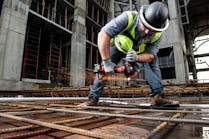Construction spending slumped in February as severe weather hammered the industry and a decline in new projects squeezed nonresidential contractors experiencing rising costs and delivery times, according to the Associated General Contractors of America. The association posted a Construction Inflation Alert to inform project owners and government officials about the threat to project completion dates and contractors’ financial health.
Construction spending in February totaled $1.52 trillion at a seasonally adjusted annual rate, a decrease of 0.8 percent from the pace in January. Although the overall total was 5.3 percent higher than in February 2020, the year-over-year gain was limited to residential construction, Simonson noted. That segment slipped 0.2 percent for the month but jumped 21 percent year-over-year. Meanwhile, combined private and public nonresidential spending declined 1.3 percent from January and 6.1 percent over 12 months.
Private nonresidential construction spending fell 1.0 percent from January to February and 9.7 percent since February 2020, with year-over-year decreases in all 11 subsegments. The largest private nonresidential category, power construction, retreated 9.7 percent year-over-year and 0.4 percent from January to February.
Public construction spending dipped 0.9 percent year-over-year and 1.7 percent for the month. Among the largest segments, highway and street construction declined 1.0 percent from a year earlier and 0.6 percent for the month, while educational construction decreased 2.3 percent year-over-year and 3.2 percent in February. Spending on transportation facilities declined 2.3 percent over 12 months and 2.5 percent in February.
Association officials said that rising materials prices and unreliable delivery schedules are making it hard for firms to remain profitable as they have difficulty passing raising prices for construction work. They said that proposed new infrastructure projects will help boost demand for many types of construction projects. But they urged Washington officials to also take steps to address supply-chain challenges, including by ending tariffs on key materials like lumber and steel.





